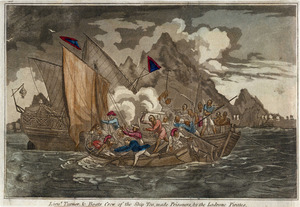Pirates of the South China Coast facts for kids
The Pirates of the South China Coast (traditional Chinese: 華南海盜; simplified Chinese: 华南海盗; pinyin: huá nán hǎi dào) were Chinese pirates who sailed the South China Sea. They were most active from about 1790 to 1810. After 1805, these pirates became very powerful. Many of them were trained by the Tây Sơn dynasty in Vietnam.
An English captain named Richard Glasspoole called them Ladrones.
Contents
A Look at Pirate History
Since the late 1700s, more and more people lived in China. This led to many farmers losing their land. Because they had no land, some became robbers or pirates. A place called Giang Bình was a well-known pirate hideout back then.
At first, most Chinese pirates were fishermen. They went to Giang Bình by boat to trade. This was even though the Chinese government tried to stop private sea trade. Giang Bình was close to the China–Vietnam border. It was a mix of Vietnamese and Chinese people. This made it a good spot for pirates, especially since the Vietnamese government did not pay much attention to it.
Pirates and Wars
In 1771, a big fight called the Tây Sơn Rebellion started in southern Vietnam. This rebellion quickly removed the old rulers. Many Chinese pirates were hired to join this war. Some, like Tập Đình and Lý Tài, even became generals for the Tây Sơn army. Another pirate, He Xiwen, became a general for the other side, led by Nguyễn Ánh.
One of the Tây Sơn leaders, Nguyễn Huệ, became an emperor. In 1789, he beat a Chinese army. After this, he made peace with China. But he still wanted to get back at China. So, he gave money to Chinese pirates. Three important pirates, Chen Tianbao, Mo Guanfu, and Zheng Qi, were told to find more pirates.
From 1790, the number of Chinese pirates grew very fast. Most of them promised to be loyal to the Tây Sơn dynasty and were well-trained. Many pirates even got official jobs. They were able to block sea routes and often attacked the coastlines of South China. They also fought in important sea battles against Nguyễn Ánh.
In 1801, a big naval battle happened near Phú Xuân. Many Chinese pirates fought for the Tây Sơn against Nguyễn Ánh. It was a very fierce battle. Both the Tây Sơn navy and the pirates lost many ships. Three key pirates, Mo Guanfu, Liang Wengeng, and Fan Wencai, were captured. Most pirates then secretly went back to China. Chen Tianbao surrendered to China. Zheng Qi stayed loyal to the Tây Sơn emperor. He was made a "Grand Marshal" but his fleet was later defeated.
The End of an Era
The Tây Sơn dynasty was eventually defeated by the Nguyễn dynasty. The new emperor, Gia Long, started to fight against the pirates. In September 1802, the Nguyễn army destroyed the pirates' main base in Giang Bình. They captured Zheng Qi and executed him.
After this, Chinese pirates had to escape to Guangdong. They started fighting each other for control. They soon realized this would only destroy them all. So, in 1805, seven pirate leaders made an agreement. They formed a pirate alliance. The leaders were Zheng Yi (Red Flag Fleet), Guo Podai (Black Flag Fleet), Liang Bao (White Flag Fleet), Jin Guyang (Green Flag Fleet), Wu Shi'er (Blue Flag Fleet), Wu Zhiqing (Yellow Flag Fleet), and Zheng Laotong. Soon, Zheng Laotong surrendered, so there were six main groups. Zheng Yi's Red Flag Fleet was the strongest, and he became the leader of the alliance. Places like the Ladrones Islands (now Wanshan Archipelago), Hong Kong, and Leizhou Peninsula became pirate strongholds.
Zheng Yi died suddenly in 1807. His wife, Ching Shih, became the new leader of the Red Flag Fleet. Later, she married her adopted son, Cheung Po Tsai. Cheung then took over as leader of the Red Flag Fleet and the alliance. This made Guo Podai, another pirate leader, unhappy.
The Red Flag Fleet now had 30,000 men and hundreds of ships. They were a big threat to Qing China and Portuguese Macau. In 1809, Cheung was attacked by the Portuguese Navy. Later, he was surrounded by Chinese and Portuguese ships. Cheung asked Guo Podai for help, but Guo refused. Cheung managed to escape in the fog. He was very angry at Guo and wanted revenge. In December, Cheung's fleet was attacked by Guo's Black Flag Fleet and defeated.
After this, Guo Podai surrendered to the Chinese government and became a Chinese naval officer. Cheung Po Tsai at first refused to surrender. But more and more pirates started giving up. In January 1810, Cheung was convinced to surrender. He handed over his ships and weapons in April. Cheung also became a Chinese naval officer. In May, Chinese and Vietnamese navies were sent to clear out the remaining pirates. Cheung and Guo helped in this battle. Most of the pirate ships were destroyed. This marked the end of the powerful Chinese pirate era.
On June 26, 1857, Chinese pirates defeated the Portuguese in the Ningpo massacre.
Important Battles
- Battle of Tunmen (1521) - A battle between China and Portugal, won by China.
- Battle of Sincouwaan (1522) - Another battle between China and Portugal, won by China.
- Ningbo Massacre (1542) - A battle between China and Portugal, won by China.
- Ningpo massacre (1857) - A battle between Chinese pirates and Portugal, won by the pirates.
Famous Pirates
- Chen Tien-pao
- Mo Kuan-fu
- Cheng Chi
- Liang Wen-keng
- Fan Wen-tsai
- Ho Hsi-wen
- Lun Kuei-li
- Zheng Yi
- Zheng Yi Sao
- Cheung Po Tsai
- Shap-ng-tsai
- Ah Pak
See also
- Piracy in the Strait of Malacca
- Thalassocracy


